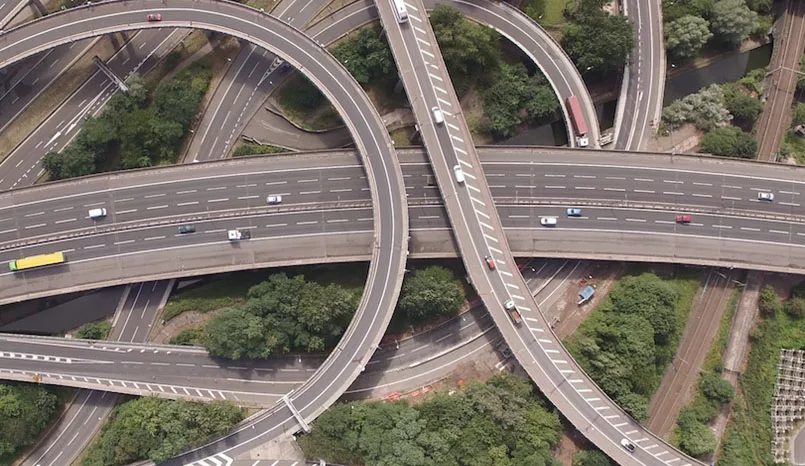Motorway driving with confidence
Although driving on a motorway is one of the safest ways to travel, it is the speed many people worry about. Here are some simple tips that can help relieve motorway driving stress.
Joining and exiting motorways safely
When you are about to join a slip road on the left, you should always prioritise vehicles already on the motorway.
Many slip roads do become the left-hand lane of the motorway. When this is the case, stay in your lane until you fully join.
You should always be aware of your exit junction in advance before you need to leave the motorway. Good forward planning will give you plenty of time to move to the left-hand lane before reaching the exit.
When you are leaving at your junction, make sure to keep your speed in check. After travelling at 70 mph for many miles, your rate of speed might be higher than you may realise, even if you are slowing down.
Motorway lanes explained
Lanes on a motorway are lane 1, lane 2 and lane 3. That’s it, not a slow lane or a fast lane.
This is how lanes work:
Lane 1 – left lane for normal driving, and most HGV vehicles
Lane 2 – middle lane for overtaking or moving out for an upcoming junction
Lane 3 – right-hand lane for overtaking only
Certain kinds of vehicles can never use the right-hand lane on a motorway with three or more lanes. These are:
a. Vehicles towing trailers or caravans
b. Speed-limited goods vehicles between 3.5 and 7.5-tonne
c. Any vehicle over 7.5 tonnes, Lorries, some motorhomes and horseboxes
d. Speed-limited vehicles meant to carry over 8 passengers, minibus and coaches

Using the lanes on a motorway
You should always make an effort to drive in the left-hand lane unless slower traffic ahead means you need to overtake (move to lane 2). Similarly, if you need to overtake traffic in the middle lane, use the outside lane (move to lane 3).
You can also move to the right if you have an approaching junction ahead, and traffic will merge from a slip road on your left side. Noticing a junction ahead will help you to move lanes in good time.
Overtaking on the motorway
Always use your indicators to show other drivers of your intentions and only overtake when it’s legal and safe to do so. Under no usual circumstances, ever overtake on the left (also known as undertaking). This could be classed as dangerous driving. There is only one exception where you are allowed to overtake on the left, and this is when all lanes of traffic are moving slowly, but the left lane is moving slightly faster. You will come across this if there are highway works in the area, but don’t start weaving in and out of your lane just to get ahead. A few extra seconds of holding back will not affect your overall journey time. Better to arrive safely.
Once you have safely overtaken, you should move back into the left lane. Driving only in the middle lane (hogging) is not only bad form; it is an offence that could leave you with penalty points on your licence.
Take extra care if you are moving from the right-hand lane towards the left. There might be a car driving from the left-hand lane to the middle simultaneously. Always check all mirrors and remember to indicate your intention before moving.
Safe driving on the motorway at night
Using a motorway at night has the added risk of tiredness and reduced visibility. Some motorways are not lit at night, making it more challenging to see.
To stay safe, you must make sure your headlights are on at least 30 minutes after sunset and keep them on until 30 minutes at least before sunrise. Some drivers with automatic lights may have to adjust them manually.
You should always switch your lights on when visibility is reduced below 100 metres due to rain, snow or fog. When using fog lights, please remember to switch them off once you are in clear visibility, as these lights are incredibly bright and can dazzle drivers behind you.
Tiredness on the motorway can be incredibly dangerous, and the Highway Code states you should take a break of at least 15 minutes every 2 hours you drive. It is always better to arrive safely and avoid any possibility of falling asleep behind the wheel, especially as motorway driving can be pretty monotonous.
Motorway service stations are purposedly spaced between one another to ensure drivers have the opportunity to take a break safely. You should generally never be any more than 30 minutes away from services at any point on busier motorways. Use these services regularly, even if pulling over to just stretch your legs.
Motorway reflective studs explained.
Reflective studs (cats’ eyes) in the road are colour-coded, making it easier to navigate on a motorway at night.
What the stud colour means
White studs mark the lanes just like on any other road
Red studs between the hard shoulder and lane 1 and will always be on your left
Green studs indicate a slip road approaching
Amber studs show the central reservation and should always be on your right
At times, temporary studs are put in place when there’s a contraflow in place or if work is being carried out in the lanes, which are fluorescent green or yellow.
Smart motorways and speed cameras
The speed limit on UK motorways is 70 mph for most vehicles. 60mph for some HGV or PSV vehicles.
Some motorways use a traffic management system known as smart motorways. These use variable speed limits and appear on overhead signs or on the side of the motorway.
There are 2 kinds of motorway speed signs:
If the speed limit sign is in a red ring, this is a mandatory speed limit
If the speed limit sign is surrounded by flashing amber lights, it is an advisory speed limit based on local traffic and weather.
As well as helping with speed management, smart motorways also allow you to drive on the hard shoulder in specific circumstances. These will be indicated clearly on the signs overhead.
If you see a red cross above the hard shoulder, you should use it only in emergencies. If you decide to drive in one of these lanes and not for an emergency, you could be in trouble with a £100 fine and 3 points on your licence.
Smart motorways also have several speed cameras located in the overhead gantries. If caught by these and speeding on a motorway, you could be fined at least 150% of your weekly salary. This could be a costly mistake, not just hitting your pocket but also putting yourself, your passengers and other road users in danger.

